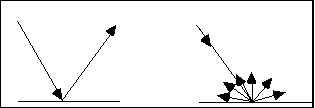Date: Sun Apr 6 10:06:25 2003
Posted By: William Payne, , Electromagnetics, Altair
Area of science: Other
ID: 1049256961.Ot
Message:
Good question! Two things need to happen for your reflection to be seen.
First, the light from you has to bounce back from the surface of the
mirror. Second, the surface has to be polished smooth, so the light will
be reflected as an image (specular) instead of being scattered everywhere
(diffused).
First, light is an electromagnetic wave. When it reaches a surface its
electromagnetic energy causes a reaction with the electrons making up the
surface. If the electrons are able to move freely, they respond by
bouncing the energy back. Most metals conduct electricity well, that is
why they make good mirrors if they are polished smooth enough.
Second, the light energy has to always bounce back at the same angle, so
the image holds together. This is a "specular" reflection that we want
from mirrors, shown on the left half of the picture. A piece of white
paper reflects more than 99% of the light, because, amazingly, at the
microscopic level the electrons are free to move, and the individual
molecules in paper conduct electricity. But a microscope shows us the
paper is really very rough, so the light gets scattered, we call it
a "diffuse" reflection, shown on the right half.
 Your household mirrors are usually made of a very thin layer of silver or
aluminum on the back of a smooth piece of glass. Nearly any material
smooth enough to give a "specular" surface will have some amount of
reflection, because the electromagnetic properties change at the boundary,
and the "boundary condition" causes some portion to be reflected. So you
see getting a smooth surface to reflect nothing at all can be as difficult
as getting a surface to reflect a perfect image.
When the frequency is very high, as in light, the wavelength can be small,
near the scale of a molecule. The electromagnetic properties often vary
quite a bit with frequency, which gives colors. For instance copper
conducts a bit better at the frequencies of red light, giving it a reddish
color.
Your household mirrors are usually made of a very thin layer of silver or
aluminum on the back of a smooth piece of glass. Nearly any material
smooth enough to give a "specular" surface will have some amount of
reflection, because the electromagnetic properties change at the boundary,
and the "boundary condition" causes some portion to be reflected. So you
see getting a smooth surface to reflect nothing at all can be as difficult
as getting a surface to reflect a perfect image.
When the frequency is very high, as in light, the wavelength can be small,
near the scale of a molecule. The electromagnetic properties often vary
quite a bit with frequency, which gives colors. For instance copper
conducts a bit better at the frequencies of red light, giving it a reddish
color.
Current Queue |
Current Queue for Other |
Other archives
Try the links in the MadSci Library for more information on Other.
MadSci Home | Information |
Search |
Random Knowledge Generator |
MadSci Archives |
Mad Library | MAD Labs |
MAD FAQs |
Ask a ? |
Join Us! |
Help Support MadSci
MadSci Network,
webadmin@www.madsci.org
© 1995-2003. All rights reserved.
 Your household mirrors are usually made of a very thin layer of silver or
aluminum on the back of a smooth piece of glass. Nearly any material
smooth enough to give a "specular" surface will have some amount of
reflection, because the electromagnetic properties change at the boundary,
and the "boundary condition" causes some portion to be reflected. So you
see getting a smooth surface to reflect nothing at all can be as difficult
as getting a surface to reflect a perfect image.
When the frequency is very high, as in light, the wavelength can be small,
near the scale of a molecule. The electromagnetic properties often vary
quite a bit with frequency, which gives colors. For instance copper
conducts a bit better at the frequencies of red light, giving it a reddish
color.
Your household mirrors are usually made of a very thin layer of silver or
aluminum on the back of a smooth piece of glass. Nearly any material
smooth enough to give a "specular" surface will have some amount of
reflection, because the electromagnetic properties change at the boundary,
and the "boundary condition" causes some portion to be reflected. So you
see getting a smooth surface to reflect nothing at all can be as difficult
as getting a surface to reflect a perfect image.
When the frequency is very high, as in light, the wavelength can be small,
near the scale of a molecule. The electromagnetic properties often vary
quite a bit with frequency, which gives colors. For instance copper
conducts a bit better at the frequencies of red light, giving it a reddish
color.